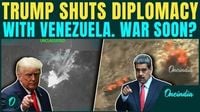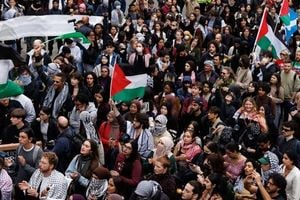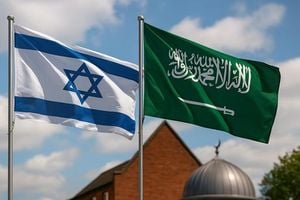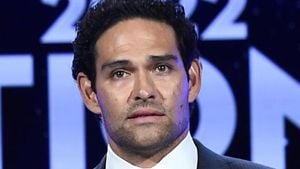On October 7, 2025, the security of U.S. embassies in Latin America became a flashpoint for international tensions, as Colombia and Venezuela found themselves at the center of heated protests, diplomatic standoffs, and threats of escalation. The day unfolded with dramatic warnings from heads of state, impassioned calls for peace, and the specter of violence looming over key diplomatic sites.
In Colombia’s capital, Bogotá, President Gustavo Petro took to the social media platform X to reassure both the international community and his own citizens that the U.S. embassy would be protected during a series of anti-genocide and anti-apartheid protests scheduled throughout the country. His message was clear: while he would not impede the planned march from the U.S. embassy in the city’s north to the symbolic Bolivar Square, the government would ensure the safety of the embassy—despite his own sharp disagreements with U.S. foreign policy.
“The government of Colombia will protect the Embassy of the US,” Petro wrote, describing the U.S. as the "main sponsor of Israel’s ongoing genocide in the Gaza Strip." He continued, “I ask protesters to abide by the rules of peace. My position differs from that of the US government, and we are attacked for it, but we stand firm on the principles of our constitution. Peace in the Caribbean and peace in the world. Respect the territory under diplomatic immunity of the US embassy.” According to the reporting of Colombia Reports, Petro’s words struck a delicate balance—acknowledging his solidarity with those protesting Israel’s actions in Gaza while upholding Colombia’s obligations under international law.
Interior Minister Armando Benedetti echoed the president’s stance, emphasizing the government’s support for protests in solidarity with the Palestinian people but drawing a firm line against violence. “There can’t be vandalism,” Benedetti stated, according to Colombia Reports. He added that the government would also protect U.S. companies operating in Colombia against possible retaliations, “despite the fact that they left [the presidential palace] unprotected” amid growing diplomatic tensions between Bogotá and Washington D.C. “The Government will GUARANTEE the security of the US Embassy in Bogota and of US companies in Colombia despite the fact they left the Casa de Nariño unprotected. In peace and for a free Palestine,” Benedetti posted.
The protests themselves were sparked by the experiences of two Colombian activists, Manuela Bedoya and Luna Barreto, who had been detained and expelled from Israel earlier that day. The pair had participated in a global flotilla aiming to break Israel’s blockade of Gaza and deliver humanitarian aid—a mission that landed them in Israeli prison for almost a week. Their subsequent expulsion galvanized activists back home, who organized marches not only as a show of solidarity with the Palestinian people but also as a rebuke to both Israeli policy and U.S. support for it.
Yet, not everyone in Colombia was on board with the demonstrations. According to Colombia Reports, the ruling class opposed the protests, with some seeking instead to commemorate victims of the Palestinian military offensive that had triggered what many now call a two-year-long genocide. The government’s public commitment to both the right to protest and the safety of foreign diplomatic sites underscored the complex balancing act facing Colombian leaders in a region where global conflicts often play out on local streets.
Meanwhile, just across the border in Venezuela, the climate was even more volatile. On the same day, U.S. President Donald Trump officially ended all diplomatic talks with the government of President Nicolás Maduro, citing escalating tensions over drug cartels and Maduro’s refusal to step down. According to OneIndia, Trump instructed Special Envoy Richard Grenell and U.S. military leaders to explore a range of options—including potential military action.
The U.S. had already increased its operations against cartel ships near Venezuelan waters, a move that alarmed regional observers and raised fears of a broader confrontation. But it was Maduro’s response that truly set nerves on edge. In a televised address, he warned of a possible attack on the U.S. embassy in Caracas and threatened to declare a “republic in arms” should the U.S. intervene in Venezuelan affairs.
“If the United States intervenes, we will declare a republic in arms,” Maduro announced, as reported by OneIndia. The threat was not merely rhetorical; it reflected mounting frustrations within his government and among his supporters, who saw the U.S. military’s increased presence near Venezuelan waters as a direct provocation.
For the U.S., the stakes were high. The embassy in Caracas, already operating under strained conditions, became a symbol of the broader struggle between Washington and Caracas—a struggle fueled by years of sanctions, political maneuvering, and mutual distrust. The abrupt end to diplomatic outreach, ordered by Trump, marked a significant escalation in a relationship that had been deteriorating for years.
In both Colombia and Venezuela, the fate of U.S. embassies became a litmus test for the state of American influence in the region. In Bogotá, the government’s promise of protection was paired with open criticism of U.S. policies—an unusual but telling sign of how global events reverberate through local politics. In Caracas, the threat of violence and the talk of armed resistance reflected a combustible mix of domestic insecurity and international pressure.
Observers note that embassies, by their very nature, are not just buildings but symbols—of power, of cooperation, and, sometimes, of division. The events of October 7, 2025, made that symbolism painfully clear. While Colombian officials sought to walk a tightrope—defending the right to protest and the sanctity of diplomatic missions—Venezuelan leaders seemed ready to use the embassy as a bargaining chip in a much larger geopolitical game.
For ordinary Colombians and Venezuelans, the day’s events were a reminder of how quickly international politics can upend daily life. In Bogotá, thousands of protesters marched peacefully, flanked by police and watched closely by the world. In Caracas, the atmosphere was tense, with rumors swirling and the embassy compound on high alert.
As the sun set on October 7, the future of U.S. diplomatic missions in Latin America hung in the balance. The coming days would test not only the resolve of regional leaders but also the capacity of ordinary citizens to channel their passions into peaceful action. Whether these embassies would remain safe havens—or become flashpoints for a new round of conflict—remained to be seen.
For now, the embassies in Bogotá and Caracas stand as silent witnesses to a region in flux, caught between protest and protection, dialogue and division, hope and fear.




